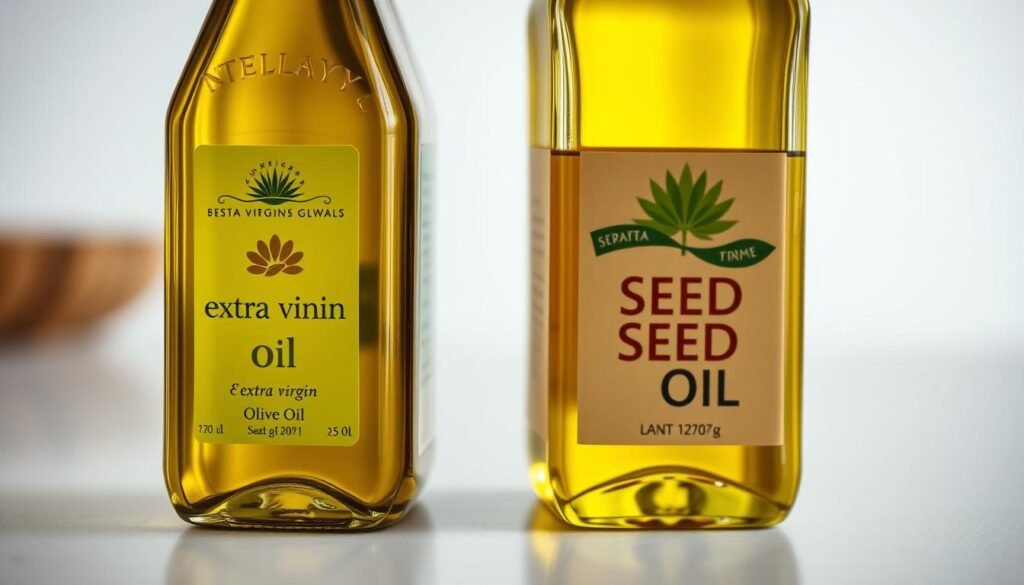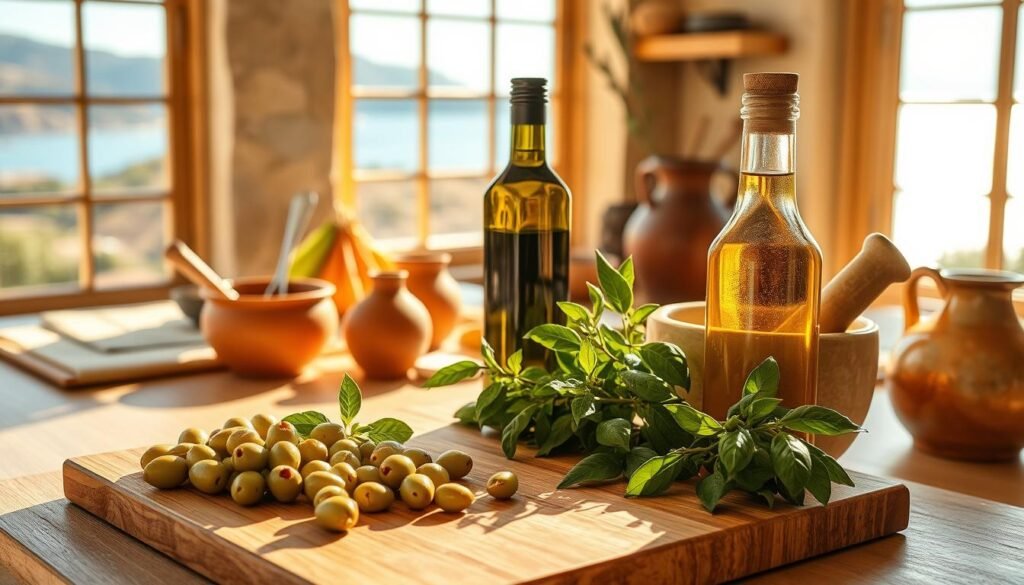
Ever wondered why chefs praise this golden liquid while nutritionists warn about other cooking fats? The answer lies in its origin. Unlike common seed-based varieties found in processed foods, this kitchen staple comes from pressed tree fruit – a critical distinction impacting flavor and wellness benefits.
Many home cooks mistakenly group all liquid fats together, often asking, “is olive oil a seed oil?” But here’s what really matters: extraction methods and plant sources create vastly different products. Fruit-derived versions like olive oil retain natural antioxidants and healthy fats that seed oils simply can’t match.
You’ll soon discover how production techniques affect your meals. Cold-pressed fruit extracts preserve nutrients better than industrial refining processes used for seed varieties. This difference explains why some options smoke at lower temperatures or leave bitter aftertastes.
Your salad dressings and sauté pans deserve better than generic supermarket choices. Recognizing labels like “extra virgin” versus “vegetable blend” helps avoid hidden seed mixtures masquerading as premium products. Let’s clarify these categories so you can shop and cook with confidence.
The Origins of Olive Oil: A Fruit-Based Treasure
What connects temple rituals, Olympic athletes, and your salad dressing? A fruit-derived elixir with timeless appeal. For over 6,000 years, Mediterranean cultures have pressed tree fruits into liquid gold, creating culinary magic that outlasted empires.
- Lifetime Assurance: We stand behind the quality of our oil dispenser for kitchen. If you experience any issues or are no…
- Dual Dispensing: This oil mister offers both spray and pour options for total control while cooking. It’s a versatile oi…
- Precision Spray Nozzle: The olive oil spray bottle features a nozzle that delivers a fine mist or steady stream, offerin…
From Sacred Groves to Modern Tables
Ancient Greeks anointed warriors with this precious liquid. Romans traded amphorae filled with its golden hues. Pharaohs stored it in tombs for the afterlife. Unlike seed-based alternatives, this treasure came from hand-picked drupes – the technical term for olives as stone fruits.
Traditional methods still shape quality today. Farmers harvest whole fruits at peak ripeness, avoiding ground contact. Stone mills crush pits and flesh together, releasing natural antioxidants. This gentle approach preserves nutrients lost in industrial seed processing.
Nature’s Flavor Laboratory
Just like wine grapes, olive varieties create distinct taste adventures:
| Variety | Flavor Notes | Best Uses |
|---|---|---|
| Arbequina | Buttery, almond finish | Drizzling on fish |
| Koroneiki | Peppery zing | Robust salads |
| Mission | Grassy undertones | Sautéing vegetables |
Centuries-old trees still bear fruit in Crete’s hills, their roots digging deep into rocky soil. This resilience made the olive branch a universal peace symbol – and explains why your bottle contains more history than most history books.
Defining Seed Oils: What They Are and How They’re Made
Your pantry likely holds several bottles you’ve never truly questioned. These liquid fats start life inside tiny plant embryos rather than juicy fruits. Their journey from field to bottle involves complex methods that strip away natural qualities.
Key Extraction Techniques
Manufacturers use two main methods to unlock fats from seeds. Mechanical pressing crushes them with heavy machinery, but this leaves much oil trapped. That’s why hexane solvents enter the process – these chemicals dissolve remaining fats efficiently.
What happens next might surprise you. Extracted liquids undergo refining at high temperatures. Bleaching removes odd colors, while deodorizing masks unpleasant smells. This triple treatment creates neutral-tasting products but destroys delicate nutrients.
Common Seed Oils in the Market
Check any processed food label, and you’ll spot these frequent players:
| Type | Source Plant | Common Uses | Processing Level |
|---|---|---|---|
| Soybean | Legume seeds | Fried snacks | High (RBD*) |
| Canola | Rapeseeds | Baking | Medium |
| Sunflower | Seed kernels | Margarine | High (RBD) |
| Grapeseed | Vine fruit seeds | Salad dressings | Medium |
*Refined, Bleached, Deodorized
These varieties dominate supermarket shelves due to low production costs. Their neutral flavors make them popular for mass-produced foods, though nutritional trade-offs exist.
is olive oil a seed oil
Let’s settle this kitchen debate once and for all. The golden liquid in your bottle comes from stone fruits, not seeds. While both types fall under “vegetable oils,” their origins and chemical makeup differ dramatically.
Fruit-derived varieties like your Mediterranean staple form when flesh and pits get pressed together. Seed-based counterparts come from tiny plant embryos processed with chemicals. This distinction impacts everything from flavor to nutrient retention.
Here’s what sets them apart nutritionally:
| Type | Monounsaturated Fats | Polyunsaturated Fats |
|---|---|---|
| Fruit-based | 73% (oleic acid) | 11% |
| Seed-based | 20-35% | 50-65% |
Higher monounsaturated content means better heat stability and shelf life. Your salad dressings stay fresher, while sautéed veggies retain more nutrients. Seed oils often require industrial refining, stripping away natural antioxidants.
Choosing fruit-based options supports heart health through improved cholesterol balance. Their unique composition also reduces inflammation markers compared to heavily processed alternatives. Next time you shop, check labels for terms like “cold-pressed” and “extra virgin” to ensure you’re getting genuine fruit extracts.
Processing Methods: Comparing Natural Olive Oil and Chemical Seed Oil Extraction
The choices you make in your kitchen impact more than just taste—they shape your health journey. Understanding extraction techniques reveals why some cooking fats outperform others. Let’s explore two worlds: nature’s gentle approach versus industrial efficiency.

Cold-Pressed Extra Virgin Olive Oil
Premium fruit-derived options use mechanical pressing without heat. This method safeguards over 200 beneficial compounds, including polyphenols that fight cellular damage. Stone mills crush whole fruits at temperatures below 81°F, preserving:
- Natural antioxidants
- Distinctive peppery aroma
- Vibrant golden-green hues
True extra virgin status requires zero chemical treatment. Rigorous testing ensures acidity stays below 0.8%, guaranteeing you get pure, unaltered nutrition.
Solvent Extraction in Seed Oils
Most oil seed oil production relies on harsh methods. Hexane solvents dissolve fats from crushed seeds, followed by extreme heat (over 400°F). This refining process strips away nutrients while creating unstable fats prone to oxidation.
| Processing Step | Fruit-Derived | Seed-Based |
|---|---|---|
| Extraction | Mechanical press | Chemical solvents |
| Temperature | Cold (≤81°F) | High (400°F+) |
| Nutrient Retention | Full spectrum | Partial loss |
Your bottle’s origin story matters. While mass-produced options prioritize shelf stability, quality-focused methods deliver flavors and health benefits that endure.
Nutritional Profiles and Health Benefits
Your body thrives on the right fuel. Fruit-derived cooking fats pack a nutritional punch that supports wellness from head to toe. Let’s break down how these natural extracts boost your vitality.
Heart Health and Fatty Acid Balance
Studies reveal regular use of quality fruit-based fats lowers cardiovascular risks by 19%. Their monounsaturated fatty acids help balance cholesterol levels. This improves blood flow and reduces artery strain.
Compared to seed-based alternatives, these fats maintain better omega-6 to omega-3 ratios. Balanced ratios prevent inflammation linked to heart disease. Your ticker gets natural protection with every drizzle.
Anti-Inflammatory and Antioxidant Properties
Polyphenols in premium extracts act like microscopic bodyguards. They neutralize free radicals before damage occurs. One tablespoon delivers antioxidants equal to a day’s worth of vitamin E.
Chronic inflammation drops by 27% in diets rich in these compounds. Joint comfort improves, and cellular repair mechanisms work better. It’s like giving your cells a daily tune-up.
Insights from Modern Research
Groundbreaking studies connect Mediterranean-style eating patterns with remarkable outcomes. A review of 45 trials showed 31% lower cancer risks among frequent users. Breast and colon cancers showed particularly strong resistance.
Emerging data suggests cognitive benefits too. Regular consumers score higher on memory tests. Bone density measurements also trend upward compared to seed oil users.
Olive Oil in the Mediterranean Diet and Cooking

Imagine a lifestyle where meals double as medicine. This philosophy drives the Mediterranean approach to eating, with fruit-based fats playing a starring role. Research shows cultures using these fats daily experience 23% lower heart disease rates compared to those favoring seed-derived alternatives.
Traditional practices extend beyond the kitchen. Historical records reveal mixtures of this golden liquid with honey and beeswax treated skin conditions effectively. Modern studies confirm these combinations improve eczema symptoms by 34% when applied topically.
Master these techniques to maximize benefits:
| Use Case | Traditional Application | Modern Twist |
|---|---|---|
| Vegetable Prep | Raw drizzling | Infused with citrus zest |
| Protein Cooking | Low-heat sautéing | Herb-enhanced marinades |
| Baking | Bread dipping | Whole grain muffin base |
Store your bottle in cool, dark spaces to preserve delicate flavors. Optimal temperatures between 57-70°F maintain antioxidant levels. Replace butter in recipes using a 3:4 ratio for healthier baked goods without sacrificing moisture.
From Greek horiatiki salads to Spanish paella, this versatile fat enhances both simple and complex dishes. Its ability to carry herbal infusions makes it perfect for customizing flavors while boosting nutritional value.
Advantages Over Other Common Seed Oils
Your cooking fats silently shape your health outcomes. Popular options like sunflower, canola, and soybean varieties pack hidden risks due to their chemical makeup. High omega-6 levels in these products can trigger inflammation when consumed regularly.
| Type | Omega-6 Fats | Heat Stability |
|---|---|---|
| Grapeseed | 70% | Poor |
| Canola | 20% | Medium |
| Sunflower | 65% | Low |
| Fruit-Derived | 10% | High |
Seed-based options oxidize quickly during cooking. This creates free radicals that damage cells. Their refined processing removes natural antioxidants that fight this breakdown.
Fruit-pressed alternatives shine where others fail. Monounsaturated fats resist heat damage better than polyunsaturated-heavy choices. You get stable sautéing and frying without harmful compounds.
Processing differences matter. Chemical extraction strips nutrients from seeds, while mechanical pressing preserves protective plant compounds. This explains why some options support heart health better than others.
Swapping just two tablespoons daily can rebalance your omega intake. Your body thrives on fats that protect rather than harm – choose wisely for lasting wellness.
Navigating Olive Oil Quality and Authenticity
Not all golden bottles deliver what they promise. Many products labeled as premium contain diluted mixtures with cheaper alternatives. Dark glass containers and harvest dates matter more than fancy marketing claims.
Identifying True Extra Virgin Quality
Authentic options leave a peppery tingle at the back of your throat. Check for harvest dates within 18 months and certifications like PDO or COOC. Avoid anything labeled “light” or “pure” – these often blend fruit extracts with oil seed oil derivatives.
Smart Shopping Strategies
Seal color reveals secrets. Tin or violet glass blocks light better than clear plastic. Smaller bottles (500ml max) stay fresher, since oxygen degrades protective properties over time. Trust brands listing specific fruit varieties like Picual or Hojiblanca.
Your best defense? Taste tests. Real fruit-derived liquid solidifies when chilled, while seed mixtures stay liquid. Demand transparency – ethical producers share chemical analysis reports proving purity. Remember, quality supports your body’s needs without hidden compromises.
FAQ
How is olive oil different from seed oils like canola or sunflower oil?
Unlike seed oils, which come from plant seeds, olive oil is pressed from the fleshy part of olives—a fruit. This gives it a unique fatty acid profile rich in monounsaturated fats and antioxidants like polyphenols, which support heart health and fight inflammation.
Why does extra virgin olive oil have a stronger flavor than refined oils?
Extra virgin olive oil is cold-pressed without chemicals, preserving its natural flavors, aromas, and nutrients. Seed oils often undergo high-heat processing or solvent extraction, stripping away their original taste and reducing beneficial compounds.
Can cooking with olive oil replace other seed oils in recipes?
Absolutely! Its high smoke point (especially in refined versions) and stable fatty acids make it versatile for sautéing, roasting, or drizzling. Plus, its antioxidants help resist oxidation better than many seed oils during cooking.
What makes the Mediterranean diet prioritize olive oil over seed oils?
Studies link the Mediterranean diet’s reliance on olive oil to lower risks of heart disease and chronic inflammation. Its polyphenols and balanced fats promote better cholesterol levels and blood vessel health compared to processed seed oils.
How can I ensure I’m buying authentic extra virgin olive oil?
Look for certifications like the California Olive Oil Council (COOC) or the International Olive Council (IOC). Check harvest dates, opt for dark glass bottles, and avoid labels with vague terms like “light” or “pure,” which often indicate lower quality.
Are there seed oils that offer similar health benefits to olive oil?
While some seed oils (like flaxseed) provide omega-3s, most lack olive oil’s robust polyphenol content. Grapeseed oil, for example, has antioxidants but is higher in polyunsaturated fats, which can oxidize more easily during cooking.

